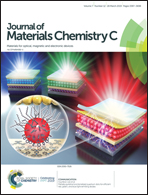Five-ring-fused asymmetric thienoacenes for high mobility organic thin-film transistors: the influence of the position of the S atom in the terminal thiophene ring†
Abstract
Two isomeric 2-hexyl substituted five-ring-fused asymmetric thienoacenes, i.e., thieno[1]benzothieno[3,2-b][1]benzothiophene (BTBTT6), in which the S atom in the terminal thiophene ring is located at different positions relative to the BTBT core, were synthesized and characterized. The syn-isomer forms bilayer “head-to-head” structures with herringbone packing modes within the layers in crystals, while the anti-isomer shows “head-to-tail” single-layer structures and sandwich-herringbone packing within the layers. The difference in packing structures involved the fact that the syn-isomer has stronger intermolecular interactions than the anti-isomer. Importantly, organic thin-film transistors (OTFTs) with near-ideal transfer and output characteristics were fabricated. Mobilities in the saturation and the linear regime (μsat and μlin) of up to 11.7 and 10.6 cm2 V−1 s−1, respectively, were achieved for the syn-isomer. This is the first report on OTFTs with both μsat and μlin above 10 cm2 V−1 s−1.



 Please wait while we load your content...
Please wait while we load your content...